Happier, more connected neighborhoods start right in the front yard
- Written by Conrad Kickert, Associate Professor of Architecture, University at Buffalo
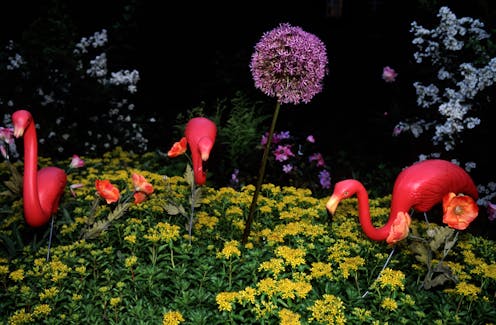 A front lawn can be a canvas for kitsch, elegance and everything in between.Jeff Hutchens/Getty Images
A front lawn can be a canvas for kitsch, elegance and everything in between.Jeff Hutchens/Getty ImagesA salve for America’s loneliness epidemic could exist right in front of its homes.
Front yards are a staple of many American neighborhoods. Lush plantings, porches or trinkets can capture the attention of passersby and spark conversation. Other lawns say “stay away,” whether it’s through imposing fences or foreboding signs.
But to what extent do yards serve as a window into the people who tend them – and how they feel about their home, neighborhood and city?
In our study of nearly 1,000 front yards in Buffalo’s Elmwood Village neighborhood, we found that the livelier and more open the front yard, the more content and connected the resident.
Cultivating a sense of place
Our study of front yards is part of a larger investigation into the ways in which American neighborhoods can cultivate a stronger “sense of place,” which refers to the feeling of attachment and belonging one feels to their home, neighborhood and city.
For decades, psychological, geographical and design research has linked sense of place to happier neighborhood residents and stronger ties among neighbors.
We decided to focus on Buffalo’s Elmwood Village for this particular study. There was the convenience factor, of course – we’re both professors at the University at Buffalo. But in 2007, Elmwood Village had also been honored by the American Planning Association as one of “10 Great Neighborhoods in America.”
We wanted to know what set Elmwood Village apart.
Located north of downtown Buffalo, this leafy neighborhood is famed for its parkways designed by landscape architect Frederick Law Olmsted, who also helped plan New York’s Central Park and Boston’s Emerald Necklace.
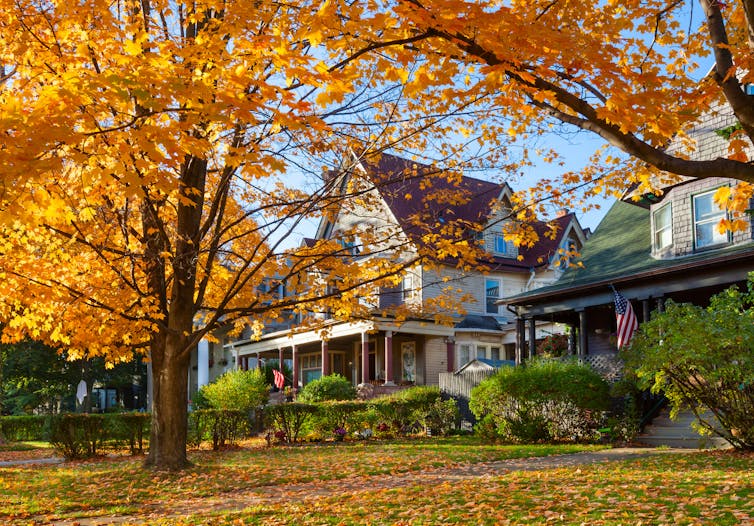 In 2007, Buffalo’s Elmwood Village was honored by the American Planning Association as one of ‘10 Great Neighborhoods in America.’benedek/E+ via Getty Images
In 2007, Buffalo’s Elmwood Village was honored by the American Planning Association as one of ‘10 Great Neighborhoods in America.’benedek/E+ via Getty ImagesElmwood Avenue is the neighborhood’s commercial heart and is surrounded by a dense blend of single-family and multifamily homes. In earlier research we had already shown that Elmwood Village’s residents have a strong sense of place. They especially appreciated the parkways and the area’s large, historic homes that had been built along tree-lined streets.
But we wanted to know whether residents could also reinforce their own sense of place from their homes, particularly the parts that are visible to all passersby.
In the precious few feet in front of the home, residents can put their values and interests on display, whether it’s garden gnomes, Little Free Libraries, elaborate gardens, sports allegiances and political loyalties.
While hanging out or working from their yards, residents can easily chat with neighbors; in fact, one study found that more than 3 out of 4 new neighborhood contacts are made from the front yard.
They’re like bridges to the rest of the neighborhood, where each resident can decide how much they want to express themselves to their neighbors and passersby. At the same time, front yards can also be used to cordon off the home, blocking views or discouraging access with fences, hedges and warnings.
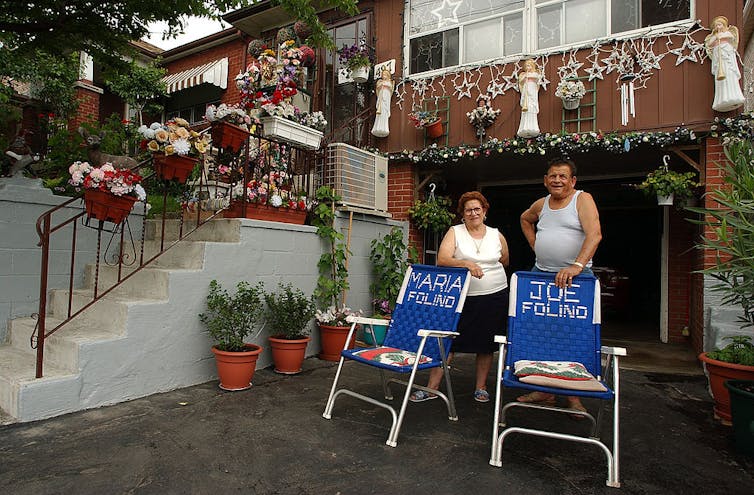 More than 3 out of 4 of new neighborhood contacts are made in the few feet in front of a home.Michael Stuparyk/Toronto Star via Getty Images
More than 3 out of 4 of new neighborhood contacts are made in the few feet in front of a home.Michael Stuparyk/Toronto Star via Getty ImagesLife in Elmwood Village’s front yards
In the fall of 2022, we assigned a team of 17 undergraduate environmental design students at the University at Buffalo to observe how residents shaped 984 front yards along 25 blocks in Elmwood Village.
A pilot study demonstrated the elements they could reliably measure: flags, expressive signs, flower pots, landscaping, toys and games, seats, porches, fences and hedges, and welcoming or unwelcoming signs. We ended up not being able to reliably track lawn care or home maintenance, since each researcher had different opinions on the measures. (Unfortunately, in this particular neighborhood, garden gnomes and Little Free Libraries were too rare to include.)
We then compared the data from the students’ fieldwork to responses from surveys we had administered asking residents about their attachment to their homes, neighbors and neighborhood; whether they felt their neighborhood had a strong identity; and if they felt they could connect to nature.
The results proved remarkably consistent. Whether they proudly displayed Buffalo Bills flags or simply had a couple of flower pots on their front porch, residents who expressed themselves with items in front of their house reported feeling a greater sense of place.
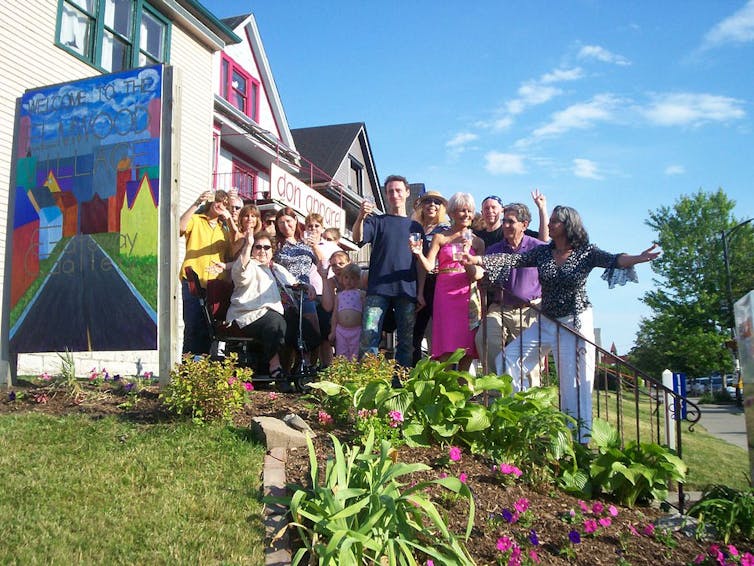 Elmwood Village residents celebrate after planting a garden and erecting a welcome sign on a front lawn in 2006.DragonFire1024/Wikimedia Commons, CC BY
Elmwood Village residents celebrate after planting a garden and erecting a welcome sign on a front lawn in 2006.DragonFire1024/Wikimedia Commons, CC BYThose with obstructions in place, such as fences and hedges, correlated to a lower sense of place. Interestingly, unwelcoming signs such as “No Trespassing” or “Smile, You’re on Camera” did not.
Even objects as simple as toys or plastic playground gear left out on the front yard seemed to foster a sense of place. To us, this says a couple of things: Homeowners trust that their property won’t get stolen, and parents don’t seem all too concerned about letting their kids play outside with neighborhood friends.
This connects to our strongest result: Elements that facilitate socializing – a garden chair, a porch, a bench – strongly boosted residents’ sense of place in every dimension and scale, whether it was their view of their home, their street or their neighborhood.
Building better neighborhoods
Our study finally validates urbanists’ decades-old contention that lively front yards make better neighborhoods.
And it turns out that places with tiny front yards, or even none at all, can also play along.
One study of Rotterdam, Netherlands, found that the port city’s residents, even with little-to-no space in front of their densely built, urban homes, nonetheless embellished their sidewalks with seats, planters and knickknacks to express themselves. These small gestures strengthened community ties and made residents happier.
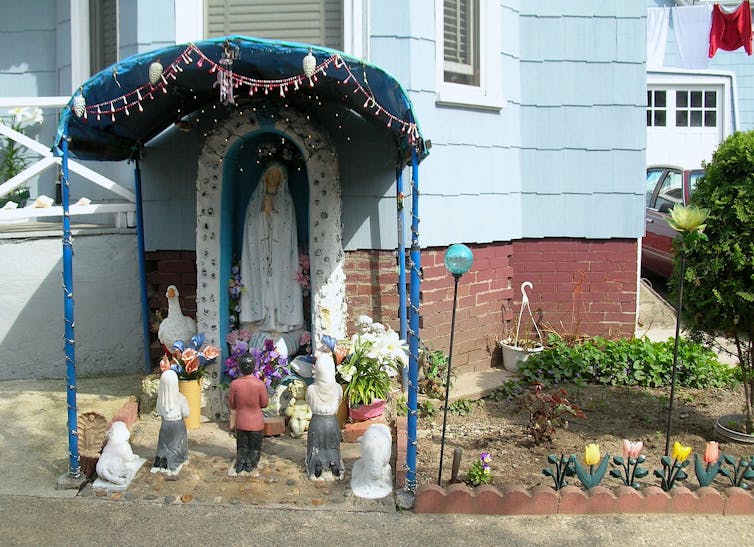 A Virgin Mary shrine in front of a home in Somerville, Mass.sushiesque/flickr, CC BY-NC
A Virgin Mary shrine in front of a home in Somerville, Mass.sushiesque/flickr, CC BY-NCIn our view, the results of our study should serve as a gentle reminder to architects, planners and developers that when they design homes and neighborhoods, they ought to create spaces for sharing values and conversations in front of homes – to prioritize porches over parking, and canvases for self-expression over saving space or money. While American designers and builders are under enormous pressure to produce more housing, they shouldn’t forget that only residents can turn them into homes.
People have an amazing ability to mold their surroundings to suit their needs – just look at what the citizens of Rotterdam were able to do.
Elmwood Village’s residents already know this, though. They’re busy organizing their next Porchfest, the annual front-yard arts and music festival that burnishes the neighborhood’s reputation as one of America’s best places to live.
The authors do not work for, consult, own shares in or receive funding from any company or organization that would benefit from this article, and have disclosed no relevant affiliations beyond their academic appointment.
Authors: Conrad Kickert, Associate Professor of Architecture, University at Buffalo

